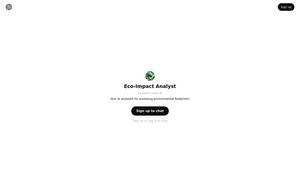
Discover the Best AI Tools to Boost Your Productivity
Find the Best AI Tools to Optimize Your Work and Personal Tasks
Best Environmental Analytics AI Tools in 2024
What is Environmental Analytics
Environmental Analytics Category focuses on leveraging data analysis to assess and address environmental impacts. It provides tools for monitoring ecological health, aiding industries like agriculture, energy, and urban planning in making data-driven decisions. Its standout feature is real-time insights, promoting sustainability.
How Environmental Analytics works
Environmental Analytics Category works by collecting data from various sources, including satellite imagery, IoT sensors, and historical environmental databases. The data undergoes analysis using advanced algorithms to generate actionable insights, allowing users to track pollution levels, predict environmental changes, and optimize resource usage. This holistic approach ensures effective decision-making for sustainability.
What are the advantages of Environmental Analytics?
The advantages of the Environmental Analytics Category include enhanced efficiency in environmental monitoring, reduced operational costs, and improved compliance with environmental regulations. The ability to receive real-time data and insights allows organizations to proactively identify potential issues and implement solutions swiftly, leading to sustainable practices and reduced ecological footprints.
Key Features for Environmental Analytics
Real-Time Data Insights
The key feature of Real-Time Data Insights in the Environmental Analytics Category allows users to access updated environmental data instantaneously. This unique aspect empowers organizations to make timely decisions, adapt strategies quickly, and effectively manage resources, ultimately leading to better sustainability outcomes.
Predictive Modeling Techniques
Predictive Modeling Techniques in the Environmental Analytics Category enable users to forecast environmental impacts based on current trends. This feature enhances strategic planning, allowing industries to proactively manage risks and implement sustainable practices, thus contributing to informed decision-making and improved environmental outcomes.
Comprehensive Data Integration
Comprehensive Data Integration is a crucial feature of the Environmental Analytics Category, allowing seamless merging of various data sources. This capability enhances users' ability to analyze multifaceted environmental issues, providing a holistic view that supports effective solutions tailored to specific environmental challenges.
Use Cases for Environmental Analytics?
Typical use cases for the Environmental Analytics Category include urban planners evaluating the environmental effects of new developments, energy companies monitoring emissions, and farmers optimizing water use through precision agriculture. Each scenario highlights how this category addresses specific challenges related to environmental health, providing tailored solutions for sustainability.
FAQs for Environmental Analytics
What are the primary benefits of using the Environmental Analytics Category?
The primary benefits of using the Environmental Analytics Category include enhanced decision-making based on accurate data, improved sustainability practices, and real-time monitoring of environmental impacts. By leveraging data insights, organizations can effectively address ecological challenges and ensure compliance with environmental regulations, leading to a greener future.
How does environmental data analytics improve sustainability efforts?
Environmental data analytics improves sustainability efforts by providing organizations with actionable insights derived from real-time data. This enables businesses to assess their ecological footprints, implement effective resource management strategies, and optimize operations, ultimately fostering long-term sustainability and enhancing their environmental impact.
In what scenarios is the Environmental Analytics Category most beneficial?
The Environmental Analytics Category is most beneficial in scenarios such as tracking air and water quality, managing urban development, and optimizing agricultural practices. By addressing specific environmental challenges, it provides tailored solutions that promote sustainability and is essential for industries committed to improving their environmental stewardship.
What unique advantage does the Environmental Analytics Category offer?
The unique advantage of the Environmental Analytics Category lies in its combination of real-time insights and comprehensive data integration. This feature allows organizations to quickly adapt to changing environmental conditions and utilize a wide range of data sources, making it a vital tool for effective and proactive environmental management.
How can the Environmental Analytics Category help organizations comply with regulations?
The Environmental Analytics Category helps organizations comply with regulations by providing precise environmental monitoring tools that track compliance metrics in real-time. This capability ensures that organizations can swiftly address any compliance issues and implement necessary changes, promoting sustainable practices while avoiding regulatory penalties.
How do users benefit from real-time data provided by the Environmental Analytics Category?
Users benefit from real-time data provided by the Environmental Analytics Category by gaining immediate insights into environmental changes. This timely information allows organizations to make swift adjustments to their strategies and operations, enhancing their ability to respond to ecological challenges and implement effective sustainability measures.





